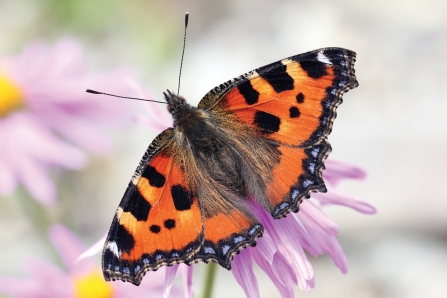Not just the stuff of fairy tales...
Striking orange and black wings adorned with crystal gems: the small tortoiseshell butterfly is easily recognisable. Dancing from flower to flower they were once abundant in gardens from the first bloom of new life until the leaves began to fall.
Imagine a warm summer’s day, walking by a meadow or in the park. Around you flits of colour parade themselves; butterflies are following their summer ritual pollinating and feeding on flowers and using their shocking colours to ward off predators.
A real nomad, able to live anywhere from mountain top to val ley bottom, the small tortoiseshell butterfly can be found almost everywhere in Britain.
Will you record one during the Great Yorkshire Creature Count?

Did you know?
- The caterpillars are black and bristly with light yellow ‘tramlines’ down their back and sides. This colouration is used to signal to predators that the caterpillars are poisonous and not worth eating!
- Males defend temporary territories from rival males as they wait for females to come along to mate with. During courtship, males ‘drum’ their antennae on females’ hindwings. Cute!
- Small tortoiseshells can use methods of ‘supercooling’ to prevent damaging ice crystals forming inside their body during the winter. This allows them to withstand temperatures as low as -20 °C without freezing!
Welcoming butterflies to your wild patch
Encourage butterflies into your garden during and after the Great Yorkshire Creature Count with the following top tips!
1) Choose butterfly-friendly plants
Plant nectar-rich flowering herbs and shrubs to feed adult butterflies. Buddleia (aka butterfly plant) is especially popular with butterflies!
2) Leave a wild patch
Leave part of your garden to grow wild and ‘messy’ – it’s likely some stinging-nettles will appear, which will provide food for small tortoiseshell caterpillars as well as many other insects. Small tortoiseshells prefer nettles in sunny but sheltered locations.
3) Help with hibernation
Leaving log piles and ivy can provide shelter for hibernating butterflies. If you find a hibernating small tortoiseshell inside your house, don’t leave it there, as it could emerge too early from hibernation when you turn the heating on. The best thing to do is to transfer it to an unheated shed or other outbuilding (not outside) where the temperature will remain more constant.
Small Tortoiseshell © Matthew Christou 2019
A dash of colour flutters by...
From the first signs of spring till the leaves begin to drop the small tortoiseshell butterfly is a regular and welcome sight in
many British gardens...
The population of the once common and widespread small tortoiseshell has collapsed by 75% since the 1970s.
Just like its cousin, the now extinct large tortoise shell butterfly, the small tortoiseshell cannot adapt fast enough to the changing climate.
Summers are dryer and flowers less rich in nectar, farmlands have fewer and fewer wild areas, gardens are in creasingly cleansed of nettles and wildflowers, warmer weather brings with new threats like parasitic flies.






